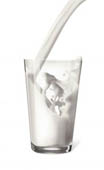
Purpose
To demonstrate the separation of casein from milk, forming a milky plastic substance.
Additional information
Casein is the predominant phosphotien (a group of proteins which are chemically bonded to a substance containing phosphoric acid) that accounts for the majority of proteins found in milk and cheese. In addition, casein is used in manufacturing of various goods including fabrics, adhesives, plastics, and protective coatings.
Sponsored Links
Required materials
- Glass full-cream milk
- Vinegar
- Eye dropper
- Long spoon or stir stick
Estimated Experiment Time
Less than 10 minutes
Step-By-Step Procedure
- 1. Ask an adult to help you warm the milk by placing it into the microwave for a minute or placing it in a bowl of hot water
- 2. Fill the eye dropper with vinegar
- 3. Slowly squirt the vinegar into the warm milk and stir with the spoon or stir stick
- 4. Make sure the mixture is not too hot, then slowly pour the milk out onto your hand (over the kitchen sink), "catching" the plastic in your fingers.
Note
Make sure the mixture is not too hot when pouring it over your hand! A mixture that's too hot will not only burn, it won't be the most effective for the experiment.
Observation
What appears to happen when the vinegar is squirted into the glass of milk and stirred? When the milk is poured from the glass, were you able to capture the milky plastic particles?
Result
The milk contains a chemical called casein. Casein can be separated from the rest of the milk using vinegar. This is a type of plastic, which is a chemical made of long chains of many small parts (atoms) joined together.
Sponsored Links
Take a moment to visit our table of Periodic Elements page where you can get an in-depth view of all the elements,
complete with the industry first side-by-side element comparisons!